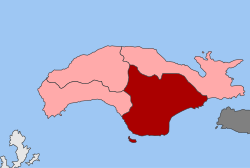Pythagoreio
|
Pythagoreio Πυθαγόρειο |
|
|---|---|

Panorama of Pythagoreio.
|
|
| Coordinates: 37°42′N 26°57′E / 37.700°N 26.950°ECoordinates: 37°42′N 26°57′E / 37.700°N 26.950°E | |
| Country | Greece |
| Administrative region | North Aegean |
| Regional unit | Samos |
| Municipality | Samos |
| • Municipal unit | 164.7 km2 (63.6 sq mi) |
| Population (2011) | |
| • Municipal unit | 7,996 |
| • Municipal unit density | 49/km2 (130/sq mi) |
| Community | |
| • Population | 1,500 (2011) |
| Time zone | EET (UTC+2) |
| • Summer (DST) | EEST (UTC+3) |
| Vehicle registration | ΜΟ |
Pythagoreio (Greek: Πυθαγόρειο) is a small town and former municipality on the island of Samos, North Aegean, Greece. Since the 2011 local government reform, it is part of the municipality Samos, of which it is a municipal unit. Population 7,996 (2011). It is the largest municipal unit in land area on Samos, at 164.662 km2 (63.576 sq mi). It shares the island with the municipal units of Vathy, Karlovasi, and Marathokampos. The archaeological remains in the town, known collectively as Pythagoreion, has designated a joint UNESCO World Heritage Site with nearby Heraion.
The seat of the municipality was the town of Pythagorio, formerly known as Tigani. The town was renamed in 1955 to honour the locally born mathematician and philosopher Pythagoras. The port of the town is considered to be the oldest man-made port of the Mediterranean Sea.
Pythagorio is built on the ancient city of Samos. Some ruins of the ancient city are today incorporated in modern houses of Pythagorio. The ancient city reached affluence around 530 B.C. under Polycrates tyrant. At that time Samos became a powerful nautical state. This power led to richness and prosperity, which is evident from great works of the period, such as the great aqueduct (part of it is the Tunnel of Eupalinos), temple of Heraion, and Samos harbour. Today many of these works can be seen in the modern town and nearby area. The ancient fortification also remains.
Samos was conquered by Persians and declined for a while. Samos flourished again for two short periods: First during the 3rd century under Ptolemy's rule (when lived Aristarchus), and second under Roman rule. The ruins of Roman period are visible today, about half a kilometre west of Pythagorio. The harbour of Samos remained important during Byzantine period. Ruins of the Byzantine period are visible in the area of Logothetis' Tower on the west side of the harbour.
...
Wikipedia


